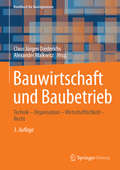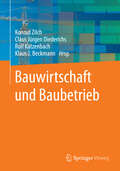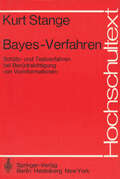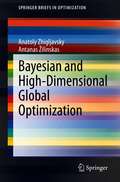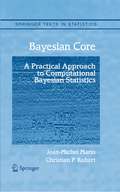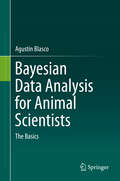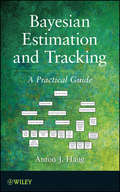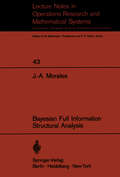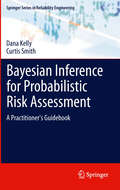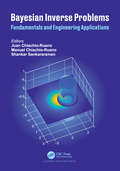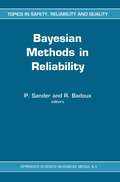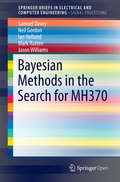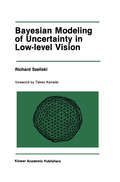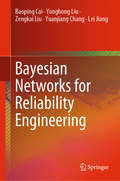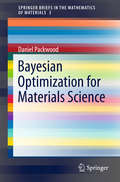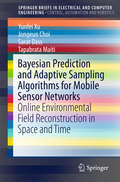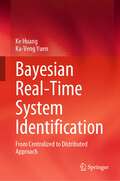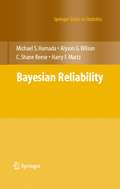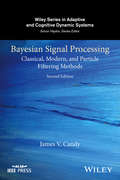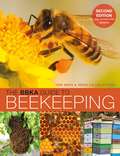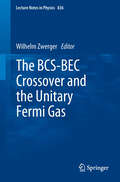- Table View
- List View
Bauwirtschaft und Baubetrieb: Technik – Organisation – Wirtschaftlichkeit – Recht (Handbuch für Bauingenieure)
by Claus Jürgen Diederichs Alexander MalkwitzDas in 3. Auflage erscheinende Standardwerk des Bauingenieurwesens bietet Grundwissen kompakt, vollständig und aktuell. Das Handbuch wurde den aktuellen Normen und Richtlinien sowie veränderten Zielen und Wertvorstellungen angepasst und versteht sich als Lehrbuch für Studierende und Nachschlagewerk für Praktiker. Es vermittelt Fach- und Methodenwissen über die Bauwirtschaft im Rahmen der volkswirtschaftlichen und betriebswirtschaftlichen Zusammenhänge, über die Unternehmensführung, die Projektentwicklung, das Immobilien- und Projektmanagement inkl. Nachtragsmanagement, über das Private Baurecht sowie den Baubetrieb und die Bauverfahrenstechnik.
Bauwirtschaft und Baubetrieb
by Konrad Zilch Claus Jürgen Diederichs Rolf Katzenbach Klaus J. BeckmannStudierende des Bauingenieurwesens werden durch kompaktes Wissen auf ihre komplexen Aufgaben vorbereitet und auf Vertiefungsmöglichkeiten hingewiesen. Praktiker können ihren Wissensstand insbesondere auch auf solchen Gebieten aktualisieren, die nicht zu ihrem Alltagsgeschäft gehören.
Bayes-Verfahren: Schätz- und Testverfahren bei Berücksichtigung von Vorinformationen (Hochschultext)
by K. StangeBayesian and High-Dimensional Global Optimization (SpringerBriefs in Optimization)
by Anatoly Zhigljavsky Antanas ŽilinskasAccessible to a variety of readers, this book is of interest to specialists, graduate students and researchers in mathematics, optimization, computer science, operations research, management science, engineering and other applied areas interested in solving optimization problems. Basic principles, potential and boundaries of applicability of stochastic global optimization techniques are examined in this book. A variety of issues that face specialists in global optimization are explored, such as multidimensional spaces which are frequently ignored by researchers. The importance of precise interpretation of the mathematical results in assessments of optimization methods is demonstrated through examples of convergence in probability of random search. Methodological issues concerning construction and applicability of stochastic global optimization methods are discussed, including the one-step optimal average improvement method based on a statistical model of the objective function. A significant portion of this book is devoted to an analysis of high-dimensional global optimization problems and the so-called ‘curse of dimensionality’. An examination of the three different classes of high-dimensional optimization problems, the geometry of high-dimensional balls and cubes, very slow convergence of global random search algorithms in large-dimensional problems , and poor uniformity of the uniformly distributed sequences of points are included in this book.
Bayesian Core: A Practical Approach to Computational Bayesian Statistics (Springer Texts in Statistics)
by Jean-Michel Marin Christian RobertThis Bayesian modeling book is intended for practitioners and applied statisticians looking for a self-contained entry to computational Bayesian statistics. Focusing on standard statistical models and backed up by discussed real datasets available from the book website, it provides an operational methodology for conducting Bayesian inference, rather than focusing on its theoretical justifications. Special attention is paid to the derivation of prior distributions in each case and specific reference solutions are given for each of the models. Similarly, computational details are worked out to lead the reader towards an effective programming of the methods given in the book.
Bayesian Data Analysis for Animal Scientists: The Basics
by Agustín BlascoIn this book, we provide an easy introduction to Bayesian inference using MCMC techniques, making most topics intuitively reasonable and deriving to appendixes the more complicated matters. The biologist or the agricultural researcher does not normally have a background in Bayesian statistics, having difficulties in following the technical books introducing Bayesian techniques. The difficulties arise from the way of making inferences, which is completely different in the Bayesian school, and from the difficulties in understanding complicated matters such as the MCMC numerical methods. We compare both schools, classic and Bayesian, underlying the advantages of Bayesian solutions, and proposing inferences based in relevant differences, guaranteed values, probabilities of similitude or the use of ratios. We also give a scope of complex problems that can be solved using Bayesian statistics, and we end the book explaining the difficulties associated to model choice and the use of small samples. The book has a practical orientation and uses simple models to introduce the reader in this increasingly popular school of inference.
Bayesian Estimation and Tracking: A Practical Guide
by Anton J. HaugA practical approach to estimating and tracking dynamic systems in real-worl applications Much of the literature on performing estimation for non-Gaussian systems is short on practical methodology, while Gaussian methods often lack a cohesive derivation. Bayesian Estimation and Tracking addresses the gap in the field on both accounts, providing readers with a comprehensive overview of methods for estimating both linear and nonlinear dynamic systems driven by Gaussian and non-Gaussian noices. Featuring a unified approach to Bayesian estimation and tracking, the book emphasizes the derivation of all tracking algorithms within a Bayesian framework and describes effective numerical methods for evaluating density-weighted integrals, including linear and nonlinear Kalman filters for Gaussian-weighted integrals and particle filters for non-Gaussian cases. The author first emphasizes detailed derivations from first principles of eeach estimation method and goes on to use illustrative and detailed step-by-step instructions for each method that makes coding of the tracking filter simple and easy to understand. Case studies are employed to showcase applications of the discussed topics. In addition, the book supplies block diagrams for each algorithm, allowing readers to develop their own MATLAB® toolbox of estimation methods. Bayesian Estimation and Tracking is an excellent book for courses on estimation and tracking methods at the graduate level. The book also serves as a valuable reference for research scientists, mathematicians, and engineers seeking a deeper understanding of the topics.
Bayesian Estimation and Tracking: A Practical Guide
by Anton J. HaugA practical approach to estimating and tracking dynamic systems in real-worl applications Much of the literature on performing estimation for non-Gaussian systems is short on practical methodology, while Gaussian methods often lack a cohesive derivation. Bayesian Estimation and Tracking addresses the gap in the field on both accounts, providing readers with a comprehensive overview of methods for estimating both linear and nonlinear dynamic systems driven by Gaussian and non-Gaussian noices. Featuring a unified approach to Bayesian estimation and tracking, the book emphasizes the derivation of all tracking algorithms within a Bayesian framework and describes effective numerical methods for evaluating density-weighted integrals, including linear and nonlinear Kalman filters for Gaussian-weighted integrals and particle filters for non-Gaussian cases. The author first emphasizes detailed derivations from first principles of eeach estimation method and goes on to use illustrative and detailed step-by-step instructions for each method that makes coding of the tracking filter simple and easy to understand. Case studies are employed to showcase applications of the discussed topics. In addition, the book supplies block diagrams for each algorithm, allowing readers to develop their own MATLAB® toolbox of estimation methods. Bayesian Estimation and Tracking is an excellent book for courses on estimation and tracking methods at the graduate level. The book also serves as a valuable reference for research scientists, mathematicians, and engineers seeking a deeper understanding of the topics.
Bayesian Full Information Structrual Analysis: with an Application to the Study of the Belgian Beef Market (Lecture Notes in Economics and Mathematical Systems #43)
by J.A. MoralesBayesian Inference for Probabilistic Risk Assessment: A Practitioner's Guidebook (Springer Series in Reliability Engineering)
by Dana Kelly Curtis SmithBayesian Inference for Probabilistic Risk Assessment provides a Bayesian foundation for framing probabilistic problems and performing inference on these problems. Inference in the book employs a modern computational approach known as Markov chain Monte Carlo (MCMC). The MCMC approach may be implemented using custom-written routines or existing general purpose commercial or open-source software. This book uses an open-source program called OpenBUGS (commonly referred to as WinBUGS) to solve the inference problems that are described. A powerful feature of OpenBUGS is its automatic selection of an appropriate MCMC sampling scheme for a given problem. The authors provide analysis “building blocks” that can be modified, combined, or used as-is to solve a variety of challenging problems.The MCMC approach used is implemented via textual scripts similar to a macro-type programming language. Accompanying most scripts is a graphical Bayesian network illustrating the elements of the script and the overall inference problem being solved. Bayesian Inference for Probabilistic Risk Assessment also covers the important topics of MCMC convergence and Bayesian model checking.Bayesian Inference for Probabilistic Risk Assessment is aimed at scientists and engineers who perform or review risk analyses. It provides an analytical structure for combining data and information from various sources to generate estimates of the parameters of uncertainty distributions used in risk and reliability models.
Bayesian Inverse Problems: Fundamentals and Engineering Applications
by Juan Chiachío-RuanoThis book is devoted to a special class of engineering problems called Bayesian inverse problems. These problems comprise not only the probabilistic Bayesian formulation of engineering problems, but also the associated stochastic simulation methods needed to solve them. Through this book, the reader will learn how this class of methods can be useful to rigorously address a range of engineering problems where empirical data and fundamental knowledge come into play. The book is written for a non-expert audience and it is contributed to by many of the most renowned academic experts in this field.
Bayesian Inverse Problems: Fundamentals and Engineering Applications
by Juan Chiachio-Ruano Manuel Chiachio-Ruano Shankar SankararamanThis book is devoted to a special class of engineering problems called Bayesian inverse problems. These problems comprise not only the probabilistic Bayesian formulation of engineering problems, but also the associated stochastic simulation methods needed to solve them. Through this book, the reader will learn how this class of methods can be useful to rigorously address a range of engineering problems where empirical data and fundamental knowledge come into play. The book is written for a non-expert audience and it is contributed to by many of the most renowned academic experts in this field.
Bayesian Methods in Reliability (Topics in Safety, Reliability and Quality #1)
by P. Sander R. BadouxWhen data is collected on failure or survival a list of times is obtained. Some of the times are failure times and others are the times at which the subject left the experiment. These times both give information about the performance of the system. The two types will be referred to as failure and censoring times (cf. Smith section 5). * A censoring time, t, gives less information than a failure time, for it is * known only that the item survived past t and not when it failed. The data is tn and of censoring thus collected as a list of failure times t , . . . , l * * * times t , t , . . . , t • 1 z m 2. 2. Classical methods The failure times are assumed to follow a parametric distribution F(t;B) with and reliability R(t;B). There are several methods of estimating density f(t;B) the parameter B based only on the data in the sample without any prior assumptions about B. The availability of powerful computers and software packages has made the method of maximum likelihood the most popular. Descriptions of most methods can be found in the book by Mann, Schafer and Singpurwalla (1974). In general the method of maximum likelihood is the most useful of the classical approaches. The likelihood approach is based on constructing the joint probability distrilmtion or density for a sample.
Bayesian Methods in the Search for MH370 (SpringerBriefs in Electrical and Computer Engineering)
by Sam Davey Neil Gordon Ian Holland Mark Rutten Jason WilliamsThis book demonstrates how nonlinear/non-Gaussian Bayesian time series estimation methods were used to produce a probability distribution of potential MH370 flight paths. It provides details of how the probabilistic models of aircraft flight dynamics, satellite communication system measurements, environmental effects and radar data were constructed and calibrated. The probability distribution was used to define the search zone in the southern Indian Ocean.The book describes particle-filter based numerical calculation of the aircraft flight-path probability distribution and validates the method using data from several of the involved aircraft’s previous flights. Finally it is shown how the Reunion Island flaperon debris find affects the search probability distribution.
Bayesian Modeling of Uncertainty in Low-Level Vision (The Springer International Series in Engineering and Computer Science #79)
by Richard SzeliskiVision has to deal with uncertainty. The sensors are noisy, the prior knowledge is uncertain or inaccurate, and the problems of recovering scene information from images are often ill-posed or underconstrained. This research monograph, which is based on Richard Szeliski's Ph.D. dissertation at Carnegie Mellon University, presents a Bayesian model for representing and processing uncertainty in low level vision. Recently, probabilistic models have been proposed and used in vision. Sze liski's method has a few distinguishing features that make this monograph im portant and attractive. First, he presents a systematic Bayesian probabilistic estimation framework in which we can define and compute the prior model, the sensor model, and the posterior model. Second, his method represents and computes explicitly not only the best estimates but also the level of uncertainty of those estimates using second order statistics, i.e., the variance and covariance. Third, the algorithms developed are computationally tractable for dense fields, such as depth maps constructed from stereo or range finder data, rather than just sparse data sets. Finally, Szeliski demonstrates successful applications of the method to several real world problems, including the generation of fractal surfaces, motion estimation without correspondence using sparse range data, and incremental depth from motion.
Bayesian Networks for Reliability Engineering
by Baoping Cai Yonghong Liu Zengkai Liu Yuanjiang Chang Lei JiangThis book presents a bibliographical review of the use of Bayesian networks in reliability over the last decade. Bayesian network (BN) is considered to be one of the most powerful models in probabilistic knowledge representation and inference, and it is increasingly used in the field of reliability. After focusing on the engineering systems, the book subsequently discusses twelve important issues in the BN-based reliability methodologies, such as BN structure modeling, BN parameter modeling, BN inference, validation, and verification. As such, it is a valuable resource for researchers and practitioners in the field of reliability engineering.
Bayesian Optimization for Materials Science (SpringerBriefs in the Mathematics of Materials #3)
by Daniel PackwoodThis book provides a short and concise introduction to Bayesian optimization specifically for experimental and computational materials scientists. After explaining the basic idea behind Bayesian optimization and some applications to materials science in Chapter 1, the mathematical theory of Bayesian optimization is outlined in Chapter 2. Finally, Chapter 3 discusses an application of Bayesian optimization to a complicated structure optimization problem in computational surface science.Bayesian optimization is a promising global optimization technique that originates in the field of machine learning and is starting to gain attention in materials science. For the purpose of materials design, Bayesian optimization can be used to predict new materials with novel properties without extensive screening of candidate materials. For the purpose of computational materials science, Bayesian optimization can be incorporated into first-principles calculations to perform efficient, global structure optimizations. While research in these directions has been reported in high-profile journals, until now there has been no textbook aimed specifically at materials scientists who wish to incorporate Bayesian optimization into their own research. This book will be accessible to researchers and students in materials science who have a basic background in calculus and linear algebra.
Bayesian Prediction and Adaptive Sampling Algorithms for Mobile Sensor Networks: Online Environmental Field Reconstruction in Space and Time (SpringerBriefs in Electrical and Computer Engineering)
by Yunfei Xu Jongeun Choi Sarat Dass Tapabrata MaitiThis brief introduces a class of problems and models for the prediction of the scalar field of interest from noisy observations collected by mobile sensor networks. It also introduces the problem of optimal coordination of robotic sensors to maximize the prediction quality subject to communication and mobility constraints either in a centralized or distributed manner. To solve such problems, fully Bayesian approaches are adopted, allowing various sources of uncertainties to be integrated into an inferential framework effectively capturing all aspects of variability involved. The fully Bayesian approach also allows the most appropriate values for additional model parameters to be selected automatically by data, and the optimal inference and prediction for the underlying scalar field to be achieved. In particular, spatio-temporal Gaussian process regression is formulated for robotic sensors to fuse multifactorial effects of observations, measurement noise, and prior distributions for obtaining the predictive distribution of a scalar environmental field of interest. New techniques are introduced to avoid computationally prohibitive Markov chain Monte Carlo methods for resource-constrained mobile sensors. Bayesian Prediction and Adaptive Sampling Algorithms for Mobile Sensor Networks starts with a simple spatio-temporal model and increases the level of model flexibility and uncertainty step by step, simultaneously solving increasingly complicated problems and coping with increasing complexity, until it ends with fully Bayesian approaches that take into account a broad spectrum of uncertainties in observations, model parameters, and constraints in mobile sensor networks. The book is timely, being very useful for many researchers in control, robotics, computer science and statistics trying to tackle a variety of tasks such as environmental monitoring and adaptive sampling, surveillance, exploration, and plume tracking which are of increasing currency. Problems are solved creatively by seamless combination of theories and concepts from Bayesian statistics, mobile sensor networks, optimal experiment design, and distributed computation.
Bayesian Real-Time System Identification: From Centralized to Distributed Approach
by Ke Huang Ka-Veng YuenThis book introduces some recent developments in Bayesian real-time system identification. It contains two different perspectives on data processing for system identification, namely centralized and distributed. A centralized Bayesian identification framework is presented to address challenging problems of real-time parameter estimation, which covers outlier detection, system, and noise parameters tracking. Besides, real-time Bayesian model class selection is introduced to tackle model misspecification problem. On the other hand, a distributed Bayesian identification framework is presented to handle asynchronous data and multiple outlier corrupted data. This book provides sufficient background to follow Bayesian methods for solving real-time system identification problems in civil and other engineering disciplines. The illustrative examples allow the readers to quickly understand the algorithms and associated applications. This book is intended for graduate students and researchers in civil and mechanical engineering. Practitioners can also find useful reference guide for solving engineering problems.
Bayesian Reliability (Springer Series in Statistics)
by Michael S. Hamada Alyson Wilson C. Shane Reese Harry MartzBayesian Reliability presents modern methods and techniques for analyzing reliability data from a Bayesian perspective. The adoption and application of Bayesian methods in virtually all branches of science and engineering have significantly increased over the past few decades. This increase is largely due to advances in simulation-based computational tools for implementing Bayesian methods. The authors extensively use such tools throughout this book, focusing on assessing the reliability of components and systems with particular attention to hierarchical models and models incorporating explanatory variables. Such models include failure time regression models, accelerated testing models, and degradation models. The authors pay special attention to Bayesian goodness-of-fit testing, model validation, reliability test design, and assurance test planning. Throughout the book, the authors use Markov chain Monte Carlo (MCMC) algorithms for implementing Bayesian analyses -- algorithms that make the Bayesian approach to reliability computationally feasible and conceptually straightforward. This book is primarily a reference collection of modern Bayesian methods in reliability for use by reliability practitioners. There are more than 70 illustrative examples, most of which utilize real-world data. This book can also be used as a textbook for a course in reliability and contains more than 160 exercises. Noteworthy highlights of the book include Bayesian approaches for the following: Goodness-of-fit and model selection methods Hierarchical models for reliability estimation Fault tree analysis methodology that supports data acquisition at all levels in the tree Bayesian networks in reliability analysis Analysis of failure count and failure time data collected from repairable systems, and the assessment of various related performance criteria Analysis of nondestructive and destructive degradation data Optimal design of reliability experiments Hierarchical reliability assurance testing
Bayesian Signal Processing: Classical, Modern, and Particle Filtering Methods (Adaptive and Cognitive Dynamic Systems: Signal Processing, Learning, Communications and Control #54)
by James V. CandyPresents the Bayesian approach to statistical signal processing for a variety of useful model sets This book aims to give readers a unified Bayesian treatment starting from the basics (Baye’s rule) to the more advanced (Monte Carlo sampling), evolving to the next-generation model-based techniques (sequential Monte Carlo sampling). This next edition incorporates a new chapter on “Sequential Bayesian Detection,” a new section on “Ensemble Kalman Filters” as well as an expansion of Case Studies that detail Bayesian solutions for a variety of applications. These studies illustrate Bayesian approaches to real-world problems incorporating detailed particle filter designs, adaptive particle filters and sequential Bayesian detectors. In addition to these major developments a variety of sections are expanded to “fill-in-the gaps” of the first edition. Here metrics for particle filter (PF) designs with emphasis on classical “sanity testing” lead to ensemble techniques as a basic requirement for performance analysis. The expansion of information theory metrics and their application to PF designs is fully developed and applied. These expansions of the book have been updated to provide a more cohesive discussion of Bayesian processing with examples and applications enabling the comprehension of alternative approaches to solving estimation/detection problems. The second edition of Bayesian Signal Processing features: “Classical” Kalman filtering for linear, linearized, and nonlinear systems; “modern” unscented and ensemble Kalman filters: and the “next-generation” Bayesian particle filters Sequential Bayesian detection techniques incorporating model-based schemes for a variety of real-world problems Practical Bayesian processor designs including comprehensive methods of performance analysis ranging from simple sanity testing and ensemble techniques to sophisticated information metrics New case studies on adaptive particle filtering and sequential Bayesian detection are covered detailing more Bayesian approaches to applied problem solving MATLAB® notes at the end of each chapter help readers solve complex problems using readily available software commands and point out other software packages available Problem sets included to test readers’ knowledge and help them put their new skills into practice Bayesian Signal Processing, Second Edition is written for all students, scientists, and engineers who investigate and apply signal processing to their everyday problems.
Bayesian Signal Processing: Classical, Modern, and Particle Filtering Methods (Adaptive and Cognitive Dynamic Systems: Signal Processing, Learning, Communications and Control)
by James V. CandyPresents the Bayesian approach to statistical signal processing for a variety of useful model sets This book aims to give readers a unified Bayesian treatment starting from the basics (Baye’s rule) to the more advanced (Monte Carlo sampling), evolving to the next-generation model-based techniques (sequential Monte Carlo sampling). This next edition incorporates a new chapter on “Sequential Bayesian Detection,” a new section on “Ensemble Kalman Filters” as well as an expansion of Case Studies that detail Bayesian solutions for a variety of applications. These studies illustrate Bayesian approaches to real-world problems incorporating detailed particle filter designs, adaptive particle filters and sequential Bayesian detectors. In addition to these major developments a variety of sections are expanded to “fill-in-the gaps” of the first edition. Here metrics for particle filter (PF) designs with emphasis on classical “sanity testing” lead to ensemble techniques as a basic requirement for performance analysis. The expansion of information theory metrics and their application to PF designs is fully developed and applied. These expansions of the book have been updated to provide a more cohesive discussion of Bayesian processing with examples and applications enabling the comprehension of alternative approaches to solving estimation/detection problems. The second edition of Bayesian Signal Processing features: “Classical” Kalman filtering for linear, linearized, and nonlinear systems; “modern” unscented and ensemble Kalman filters: and the “next-generation” Bayesian particle filters Sequential Bayesian detection techniques incorporating model-based schemes for a variety of real-world problems Practical Bayesian processor designs including comprehensive methods of performance analysis ranging from simple sanity testing and ensemble techniques to sophisticated information metrics New case studies on adaptive particle filtering and sequential Bayesian detection are covered detailing more Bayesian approaches to applied problem solving MATLAB® notes at the end of each chapter help readers solve complex problems using readily available software commands and point out other software packages available Problem sets included to test readers’ knowledge and help them put their new skills into practice Bayesian Signal Processing, Second Edition is written for all students, scientists, and engineers who investigate and apply signal processing to their everyday problems.
The BBKA Guide to Beekeeping, Second Edition
by Roger Cullum-Kenyon Ivor DavisThe number of people interested and active in keeping bees at an amateur level has continued to increase over the past few years in both rural and urban situations. This guide, aimed at beginning beekeepers, and the only one to be endorsed by the BBKA provides an authoritative text, along with clear photographs and illustrations.The book introduces the reader to beekeeping, including such areas as the workings of the colony, the structure of a hive, how to acquire bees and keep them healthy and what happens in each month in a beekeeping year.Each chapter is accompanied by anecdotes, answers to frequently asked questions and fascinating facts about bees and honey.The new edition includes new step-by-step sequences to illustrate procedures such as containing a swarm, identifying the queen, using a smoker and cleaning a hive as well as more information on different kinds of hives, disease management and many other key areas.
The BBKA Guide to Beekeeping, Second Edition
by Ivor Davis Roger Cullum-KenyonThe number of people interested and active in keeping bees at an amateur level has continued to increase over the past few years in both rural and urban situations. This guide, aimed at beginning beekeepers, and the only one to be endorsed by the BBKA provides an authoritative text, along with clear photographs and illustrations.The book introduces the reader to beekeeping, including such areas as the workings of the colony, the structure of a hive, how to acquire bees and keep them healthy and what happens in each month in a beekeeping year.Each chapter is accompanied by anecdotes, answers to frequently asked questions and fascinating facts about bees and honey.The new edition includes new step-by-step sequences to illustrate procedures such as containing a swarm, identifying the queen, using a smoker and cleaning a hive as well as more information on different kinds of hives, disease management and many other key areas.
The BCS-BEC Crossover and the Unitary Fermi Gas (Lecture Notes in Physics #836)
by Wilhelm ZwergerRecent experimental and theoretical progress has elucidated the tunable crossover, in ultracold Fermi gases, from BCS-type superconductors to BEC-type superfluids. The BCS-BEC Crossover and the Unitary Fermi Gas is a collaborative effort by leading international experts to provide an up-to-date introduction and a comprehensive overview of current research in this fast-moving field. It is now understood that the unitary regime that lies right in the middle of the crossover has remarkable universal properties, arising from scale invariance, and has connections with fields as diverse as nuclear physics and string theory. This volume will serve as a first point of reference for active researchers in the field, and will benefit the many non-specialists and graduate students who require a self-contained, approachable exposition of the subject matter.
